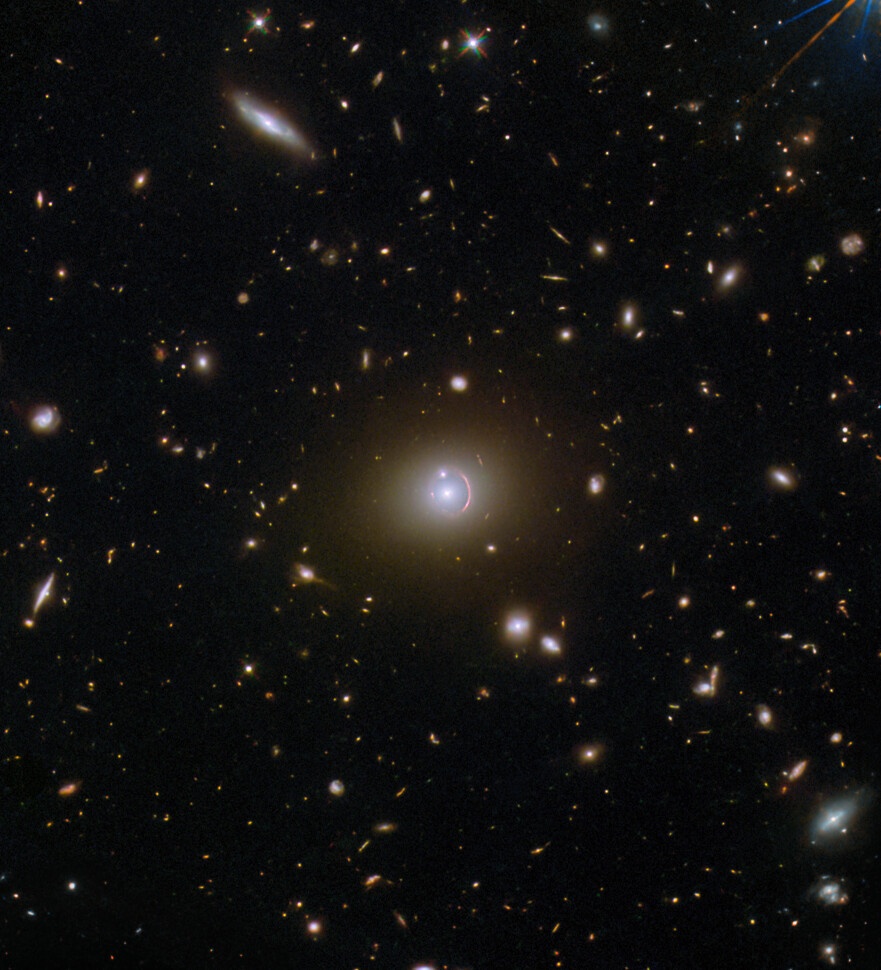Another Example of a Fantastic Einstein Ring
By Carolyn Collins Petersen
The most evocative astronomy images take us across space and time to stars and galaxies billions of light-years away. Nestled at the center of this one, taken by the Hubble Space Telescope, is a collection of three galaxies. They’re not all that close together, although they appear to be in this image. What’s fascinating about this image is that it’s a fine example of an Einstein gravitational ring—and its discovery was enabled by members of the public!
Let’s examine this image in more detail. Start with the central point source of light. It’s a foreground galaxy called SDSS J020941.27+001558.4 that lies nearly three billion light-years away. It’s likely home to millions or billions of stars, planets, nebulae, and other objects. There’s another galaxy, called SDSS J020941.23+001600.7, that appears just above the central one—and it, too, is home to millions of stars.

Both of these galaxies look like they’re surrounded by a reddish ring of light. Believe it or not, that’s also a galaxy. But, what we see is its distorted image. It’s very distant and we see it as it was when the Universe was only 2.6 billion years old.
Warping a Galaxy into an Einstein Ring
So, the distant lensed galaxy—HerS J020941.1+001557—isn’t ring-shaped. It just appears that way due to a fantastic confluence of gravitational effects. The galaxy lies almost directly behind the closer one (the central point of light). As the distant galaxy’s light travels across space, it moves through the gravitational field of the intervening galaxy. That “bends” the light and distorts the appearance of the galaxy into the ring shape we see here. It’s called an “Einstein Ring” because the gravitational field of the galaxy (or in some cases an intervening galaxy cluster) creates a “lens” that distorts the light.

Einstein’s theory of general relativity predicts that strong gravitational fields affect light as it passes through (or nearby). If all the pieces are in a perfect line with each other (that is, the background galaxy, the gravitational source, and Earth) then you get a perfect ring shape. Even a small deviation from a perfect lineup will result in a gravitational arc or partial ring. That’s what we see here.
Finding Einstein Rings Via Space Warps
While Einstein rings are relatively rare, examples of gravitational lensing exist across the Universe. As it turns out, lensed images of distant galaxies and quasars provide interesting science. Just as an example, the amount of lensing that distorts a distant object’s image tells astronomers a lot about the lensing galaxy or galaxy cluster. Once they have that information, researchers can use it to “reconstruct” the background galaxy and learn more about its stars. Lensing offers a way to see ancient galaxies, and can even track such things as supernova explosions in those distant objects. Scientists use lensed objects to learn more about dark matter and its properties, and even to estimate the expansion rate of the Universe.
Hubble and other telescopes have taken many images of these cosmic lineups, more than there’s time to examine fully. A group of astronomers gathered up images from the Subaru Telescope’s “Hyper Suprim-Cam” (HSC) instrument and put them into a database. Those images are part of a huge survey of the sky that HSC performed. And, scientists estimated that there could be hundreds of lenses captured in HSC’s images. They decided to make them available via Zooniverse, a citizen-science portal. Then, they invited members of the public to sort through the images as part of a project called Space Warps. The goal was to look for lenses. In particular, they wanted to find Einstein Rings.

In January 2014, citizen scientists on the Spacewarps site identified this lens in the HSC data. It was the result of many hours of gravitational lens classifications performed on the HSC data. They were one of four groups that found this lens, and it was also identified in images from the Canada-France-Hawai’i Telescope, the Herschel telescope, and the Planck probe. Since that time, the lens has been studied by many other telescopes, including Hubble.
Using Lenses to Probe the Universe
Gravitational lenses like this one provide a unique way to study early epochs of cosmic time. The careful study of warped galaxies and quasars gives insight into what they looked like when the Universe was very young. We can follow their formation, the creation (and deaths) of their stars, and how smaller galaxies combined to form larger ones. Lensed images of active galactic nuclei might also give some serious hints as to the formation of central supermassive black holes in early history.
Think of gravitational lenses as a way to probe dim and distant areas of the Universe. They’re almost like time machines, giving us a clearer look at ancient cosmic events and processes. Some of these lenses are not as dramatic as this one, but even the weaker ones show us glimpses of more distant objects and provide insight into the gravitational structures that create them.
For More Information
So Near, or So Far?
Searching for Strong Gravitational Lenses in the Hyper Suprime-Cam (HSC) Survey
The post Another Example of a Fantastic Einstein Ring appeared first on Universe Today.

January 11, 2024 at 03:39AM
via Universe Today read more...

Post a Comment